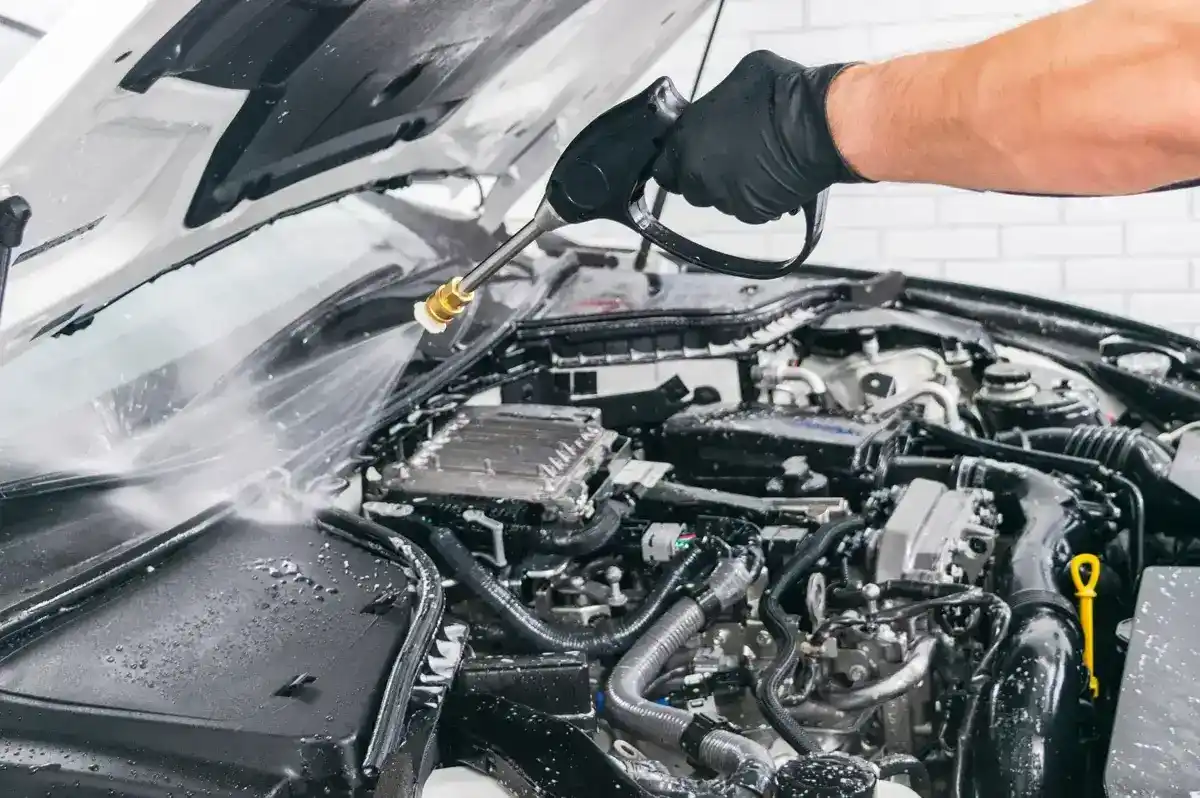How to clean your car’s engine
22 May 2024

The engine bay of your car is where your car’s engine and associated components are housed, usually at the front of your vehicle, underneath the hood. It is sometimes referred to as the engine compartment.
Home to essential parts such as the engine block, radiator, battery hoses, belts and fluid reservoirs, you can usually access your vehicle’s engine bay by propping open the bonnet or hood.
While many people take care to keep their cars clean and shiny on the outside, the engine bay is often overlooked. However, dirt and grime can easily accumulate, and may even start to affect engine performance or lead to corrosion over time. To prevent this, it’s a good idea to clean your engine bay periodically.
In this article, we’ll cover some instructions on how to clean your car’s engine bay, plus a list of the things you’ll need and some safety precautions to take.
Safety precautions
Before you begin cleaning your engine bay, be sure to establish a safe working environment to avoid accidents. You need to be a bit more careful when cleaning beneath the hood than you would be when washing down the body of your car, due to the presence of electrical components.
- Make sure your car’s engine is fully cold before beginning any work. Do not clean a car engine that has recently been running.
- Disconnect the negative battery terminal to prevent electrical hazards.
- Use waterproof covers to protect sensitive electrical components from water.
What you’ll need to clean your car’s engine bay
The good news is that you don’t need any specialist equipment to clean your car’s engine bay. Simply gather the following household cleaning equipment before you begin:
- Soapy water solution in a spray bottle
- Degreaser cleaning spray
- Soft bristle brushes in various sizes
- A garden hose with a low-pressure spray nozzle
- Rags or microfibre cloths
- Baking soda (an optional extra)
How to clean car engine bay step-by-step
Make sure your engine is fully cold and do not attempt cleaning if your car has recently been running. Before you begin, disconnect the negative battery terminal. The battery terminal looks like a rectangular box with two posts labelled positive (+) and negative (-).
The positive post may be red while the negative tends to be black or blue. Use a wrench or pliers to loosen the nut that’s holding the negative terminal in place, and remove it using your hand. Gently lift the terminal off the post and tuck it somewhere safe to avoid accidental contact.
Don’t forget to protect components such as the battery, ignition wires, alternator, air intake and control unit with plastic bags or waterproof covers.
Now, for the cleaning:
- Start by removing large and loose debris such as leaves or twigs with a soft brush or compressed air.
- Apply degreasing solution to any greasy or oily areas, allowing it to sit according to the product instructions.
- Use bristle brushes to loosen the set in dirt and grime.
- Carefully rinse with a gentle stream of water, taking care not to spray directly onto any electrical components.
- If necessary, neutralise any battery terminal corrosion with a water and baking soda solution.
- Finish by wiping the entire engine bay dry with a rag or microfibre cloth. Don’t forget to reconnect the negative battery on the terminal and remove any waterproof coverings.
Once your engine is clean and dry, it’s time to reconnect the battery terminal. Simply place it back over the negative post and secure it in place with the nut. When the battery is reconnected, test if it is working properly by attempting to start the car, and check all electrical components are functioning as they should.
Why should you clean your engine bay?
While not necessarily essential, cleaning your car’s engine bay takes less than an hour or so and can result in a range of benefits:
- Helps you detect problems: Identifying leaks and common issues before they cause irrevocable damage is more likely when you regularly get up close and personal with what’s going on beneath your bonnet.
- Enhances engine performance: Leaves, dirt and debris can gradually accumulate in nooks and crannies, obstructing vital components and reducing vital airflow. This hinders the combustion process, leading to a less responsive engine and lowered fuel efficiency.
- Extends engine life: Keeping a clean and well-maintained engine is a great habit to extend engine life. When it gets neglected, dirt and grime can build up and lead to corrosion, eventually wearing down essential engine components. This is especially true for vehicles that are regularly driven off-road.
- Preserves electrical components: Keeping your car battery clean can improve its performance and extend its lifespan. The same goes for the spark plug and the alternator, which can become clogged with dirt over time.
- Maintains appearance and resale value: While not immediately visible, a filthy engine bay would be off putting to a potential buyer, who may see it as a sign of overuse and poor maintenance. By keeping your car’s engine bay in good condition, you are boosting its resale value when the time comes to sell.
Cleaning your car engine bay is ultimately a beneficial task to add to a preventive maintenance schedule, alongside other essential tasks such as checking your engine oil and regularly topping up fluids and lubricants.

